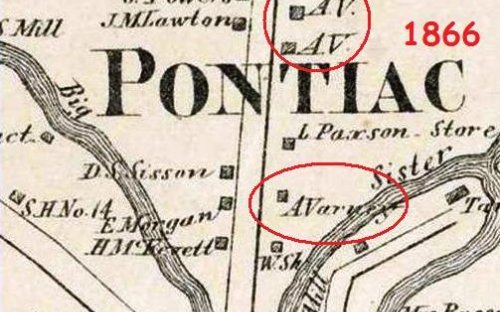This information is from: http://orbitist.com/2014/07/07/anti-slavery-activists-in-the-1800s/
By Douglas H. Shepard
This location is Private property.
Andrew Varney is most likely the Friend Andrew cited as an Underground Railroad conductor and stationmaster by Eber M. Pettit in Sketches in the History of the Underground Railroad. Pettit four times refers to a mysterious “Friend Andrew,” an important Underground Railroad agent, apparently a Quaker. There are a few other clues in Pettit’s account as to “friend Andrew’s” age and location. On p.14 of the 1999 annotated edition by Paul Leone, Friend Andrew has arrived at Black Rock by carriage, carrying “Dan,” a runaway slave. Andrew is wearing a hat with “a broad brim,” and Pettit refers to him as an “old man.” That was in January 1858.
On p.17 we follow a refugee’s route from Warren PA, Jamestown, Ellington and Leon to Pettit’s station in Versailles. The fugitive, Tom Stowe, immediately left Pettit’s place, forded the river (Cattaraugus Creek) “and going through the dark woods (a horrible road in those days) arrived before daylight at Friend Andrew’s hospitable station….Another idle day was passed and the next morning Andrew put him on a boat at Black Rock.” In other words, Friend Andrew lived close enough to Black Rock to reach it quickly in the morning.
On p. 94 Pettit describes the refugees William and Margaret Holmes leaving Fredonia at 3 p.m. in deep snow and cold temperatures. They were brought to the Versailles station and then “found themselves rising the east bank of the Cattaraugus Creek (the crossing was on the ice, there being no bridge at that time), on the way to friend Andrew’s station.”
If we put those clues together with some external evidence, we find that the most likely candidate is Andrew Varney of the small settlement called Pontiac in Evans township in Erie County, New York. Andrew Varney was born in Berwick ME on 27 March 1797 to Joshua and Anne Varney. He and his family were there in 1820 and in Porter, Oxford ME at the time of the 1830 Census. By 1840 they were in Evans NY where they continued to live. Andrew Varney’s house can be seen in the “Pontiac” section in the 1866 atlas of Erie County in the Maps Division of the New York Public Library. He died in Pontiac on 27 October 1868 and was buried in the North Collins Quaker cemetery.
There was a Quaker census done in 1828 to record the names of members of the New York yearly meetings of the Religious Society of Friends at the time of a schism between “Hicksites” and “Orthodox” Quakers. Andrew Varney’s involvement can be traced from his membership in the Troy-Pittstown meeting of 1819. On 1 September 1824 he became a member of the Starksborough monthly meeting and on 1 April 1825 he was married at the Hamburg monthly meeting to Mary Stevens.
Their son, Austin F. “James” Varney was born in Brant NY in 1828. He hosted Sojourner Truth in his home in 1868. A narrative of that visit was written by Phebe Merritt Varney. She was 29, living with her parents, Isaac and Mary Varney in North Berwick ME in 1850. By 1860 she was living with James Varney, listed as a “domestic,” although she may already have been married to him. There was a “Mart [Merritt] Varney,” six years old in the family as well. The family is the same in 1870, but the 1880 Census has James and “P. Varney” as well as Merritt, 26, and Pauline Varney, 40. The 1866 Evans map shows Jas. A. F. Varney on Mileblock Road (Lot 12) with a lot assigned to M. F. Varney across the way. James’ father’s house is located in Pontiac (Lot 14) designated on the map by “A.V.”
Source: Sketches in the history

